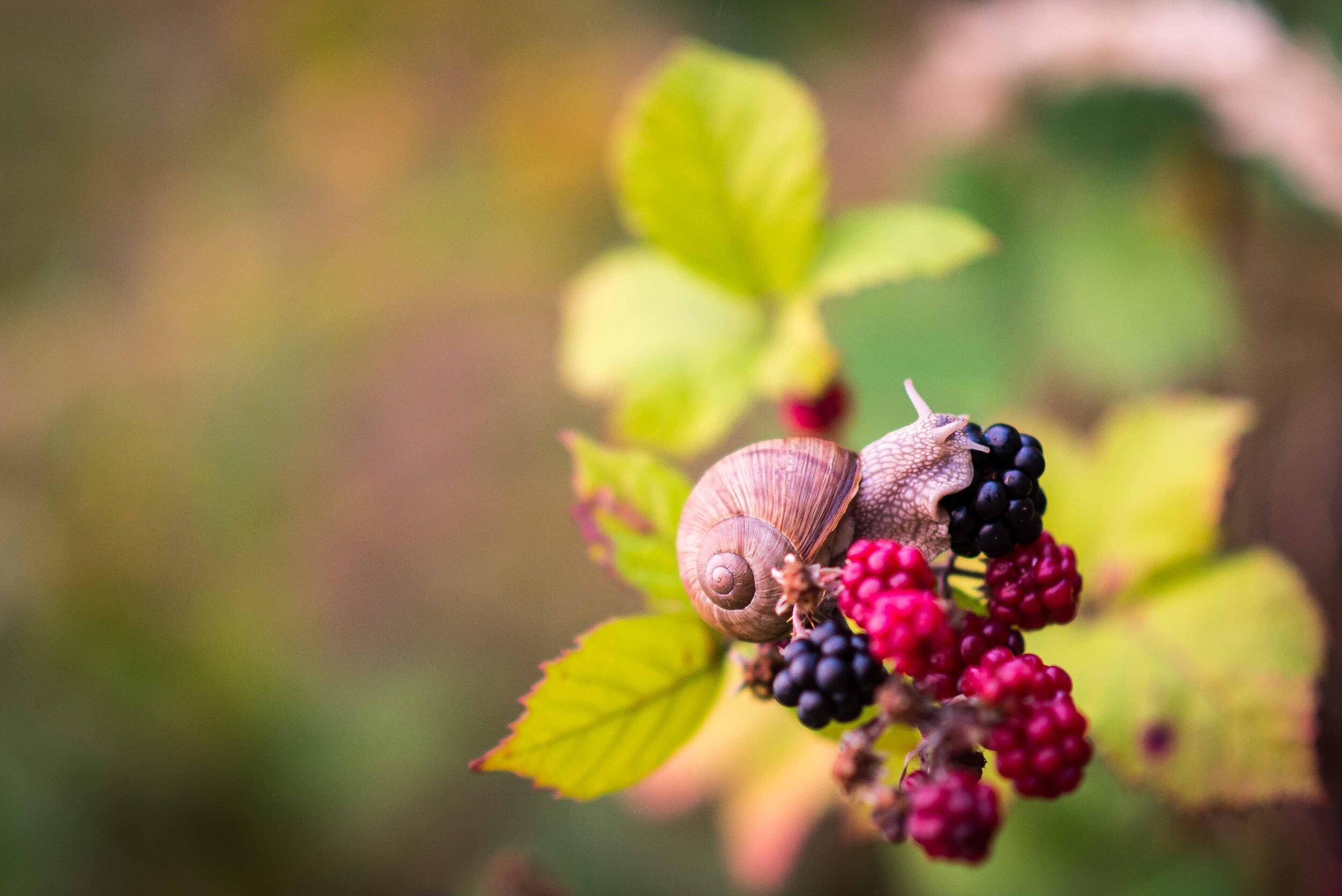Blackberry Season Is Upon Us!
Blackberry season has officially started here in Oregon. What used to be walls of pinkish-white blossoms have turned into brambles dotted with ripening berries. The season is just now starting to produce sweet, luscious berries that are perfect for eating right off the vine or turned into delicious desserts. There are a few things to consider, however, before heading out to harvest these dark gems for yourself.
Blackberry Blossoms Are Very Light Pink, Signaling Fruit Yet To Come.
How to Identify Blackberries
With the abundance of blackberry thickets you see around you’d think that they were a native species in the Pacific Northwest. Turns out you are right, there are some blackberries that are native to the area, but chances are they are not the one growing in your local park.
Rubus Ursinis: The Pacific Northwest’s Native Blackberry
You likely haven’t seen the variety of blackberry that is native to the Pacific Northwest. Also called ‘trailing blackberry’ or ‘dewberry,’ their Latin name (Rubus Ursinus) roughly translates to ‘bear bramble',’ so when you find some keep an eye our for a berry-loving bear! The trailing blackberry is much more low growing than their non-native cousins, and have sharper features. The stems are relatively thin and ‘trail’ along the ground up to 30 ft. The borders of the leaves are sharply ‘toothed’ and usually sprout in groups of three (although sometimes one or five). Just as you would expect, the berries are oblong and dark purplish black, and they’re usually ready to harvest throughout July and August.
Native Blackberries Have Sharp, Deeply Incised Leaves That Typically Grow In Groups of Three.
Rubus Armeniacus: Himalayan Blackberry Are Easy To Find And Identify
Himalayan blackberries are all over in the Pacific Northwest. They are actually an invasive plants that were originally introduced to the U.S. in the 1800s and have grown wildly all over. These are the walls of brambles that you’re used to seeing along roadsides and lining parks, growing up to 15 ft tall and 40 ft wide. Depending on the age of the vine, leaves typically grow in groups of three or five and have serrated edges. Similar to their native cousins, the fruit growing on these vines ripens to a dark, juicy berry. The harvesting season is usually a little later than that of the native blackberries and the time for the fruit to ripen is a little bit longer. But, if you know of a particularly sunny spot, you can start picking a little earlier. Just make sure to know what you’re looking for.
Common Himalayan Blackberries Have Serrated Leaves That Typically Grow In Groups Of Five.
Where To Harvest Blackberries
Finding a worthy blackberry thicket to call your own can be trickier than it sounds. I’ve got a couple tips for you on things to avoid when harvesting wild blackberries.
Avoid Blackberries Growing Along Roadways
Blackberries grow great along roadways, especially highways, because there tends to be lots of sunlight and space for them to grow. You know what else is along roadways? Grime. Think of all of the exhaust and other various road grime that is coating that fruit. If you happened to find some otherwise unscathed fruit on the ground in the middle of the road would you pick it up and eat it? Probably not. The other thing to consider with roadways is herbicides. Maintenance crews very likely have sprayed some kind of herbicide along the roadway to keep things from getting out of control and taking over the roadway.
Blackberries Near Roadways Are Likely Covered in Road Grime and May Have Been Sprayed With Herbicide. (Photo by JOHN TOWNER on Unsplash)
If you find a bunch of blackberries along a roadway, start looking for a side trail or a park nearby. Where there are some, there are likely more. Getting to them could be tricky due to all of the thorns and whatnot, but you’re a creative and adventurous person. I believe in you!
I should also note that just because blackberries are not along a roadway does not mean that they haven’t been sprayed with herbicides. Spraying is most effective toward the end of the season, but it could happen any time of the year. Try contacting your local parks or transportation department to ask about spraying if you have a particular harvest location in mind.
Avoid Low-Hanging Fruit
What I mean when I say avoid low-hanging fruit is that you should avoid any berries growing close to the ground where, say, an animal (dog, drunk person, etc.) may have helped to water them. They go low, make sure that you go high!
Only Harvest Perfectly Ripe Berries
Blackberries start out very light in color and then turn from red to purplish black in color. They are perfectly ripe when they are dark, plump, and shiny. The real test for ripeness is when you go in for the harvest. The berries should easily come off the stem. If you have to really pull the berry off the stem it’s not ready yet; it’ll be super tart. Don’t pick it in the hopes that it will ripen in the bowl. Unfortunately that’s not how blackberries work, they stop ripening once you pick them. Keep that one in mind for next time. It’ll probably be perfectly ripe in a couple of days.
You should also avoid over-ripe berries. They tend to be mushy and dull looking. Plus, over-ripe fruit is more likely to have critters in it. I hate to break it to you, but most of the berries have critters in them. Critters like berries too.
The Truth About Bugs
It’s one of those things that you just kind of wish you didn’t know, but I don’t want to lie to you. If you want to go on thinking that your blackberries are bug free stop reading right here. The truth is, there are definitely bugs in your blackberries. In the late 2000s a variety of fruit fly that evolved knowing and loving the original Himalayan Blackberries made its way to the U.S. Since then, the lady flies have been using berries of all kinds as little nurseries for their babies. The upside is that these little hitchhikers are safe to eat. Plus, if you pick ripe, but not over-ripe fruit, you are less likely to have little wormies. That being said, you can and should always wash your fruit, which should wash away some of the little guys.
How To Wash Blackberries
I have always been in the habit of rinsing fruit before eating it to make sure to get any dirt or other unwanted particles off. At a minimum, I put the fruit in a colander, slowly run water over the fruit, and gently toss everything a few times before turning the berries into a paper-towel-lined bowl. I’ve changed my game plan a little bit based on the above information about baby bugs. There is no guarantee that you’ll get rid of all of the bugs, but to deal with at least some of them you can use salty water. Fill a large bowl or stock pot with cold water and add a couple tablespoons of salt. Stir to dissolve the salt. When ready, place the blackberries in the colander and submerge them in the water for about 10 minutes. The bugs should emerge from their hiding spots and float to the top of the water. Pour them off, rinse the berries as you normally do, and spread them out to dry. If it makes you feel better, you could dunk ‘em a couple of times just to be sure you’ve taken care of as many bugs as possible.
Make Sure To Thoroughly Wash Your Blackberries Before Eating.
Once clean and dry, enjoy your berries! They keep in the fridge for a couple of days at most, but they never last very long in our house. I usually just keep a bowlful of washed berries on the counter and munch on them throughout the day. When we’re out and have a hankering for more, we’ll just run down to the local park and harvest some more. The beautiful thing about blackberries is that they keep ripening throughout the summer, so you can go every couple of days for a fresh supply!






